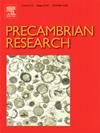Pb-Pb age of Vanivilas carbonates of the Chitradurga group − significance to the timing of emergence of continental crust of the Dharwar Craton
IF 3.2
2区 地球科学
Q2 GEOSCIENCES, MULTIDISCIPLINARY
引用次数: 0
Abstract
Marine, chemically precipitated carbonate rocks are scarce in Archean cratons, yet they provide crucial geochemical archives for reconstructing early ocean–atmosphere evolution. The Vanivilas Formation in the Chitradurga greenstone belt of the Dharwar craton, represents one such carbonate sequence, offering insights into seawater chemistry, depositional conditions, and post-depositional alteration. Determining the precise age of Archean carbonate rocks is challenging, and is usually constrained by zircon ages of underlying and overlying magmatic rocks. The age of Vanivilas carbonates remains unknown and is considered to be older than 2.7 Ga based on magmatic zircon ages from the younger Ingaldhal Formation. In this study, we integrate Pb isotopic analyses and REE + Y systematics, to constrain the age of the Vanivilas carbonates Formation using Pb-Pb isotope system. Three carbonate samples from outcrops of the Vanivilas Formation yielded isochrons corresponding to ages of 2801 ± 22 Ma, 2621 ± 33 Ma, and 2648 ± 37 Ma, marking distinct geological episodes. The Pb-Pb age of 2801 ± 22 Ma represents the time of diagenesis, predating the U-Pb zircon ages of the overlying felsic volcanic rocks of the Ingaldhal Formation and postdating the detrital zircon ages reported from the underlying phyllites, thereby refining the depositional chronology of the Vanivilas Formation. REE + Y signatures confirm a marine origin, characterized by LREE depletion, HREE enrichment, superchondritic Y/Ho ratios (>49), and positive EuSN, LaSN, and GdSN anomalies, indicative of a hydrothermally influenced, seawater composition. The absence of a Ce anomaly suggests that the Chitradurga Sea remained largely anoxic, consistent with prevailing Archean Ocean conditions.
The younger Pb-Pb ages (2621 ± 33 Ma and 2648 ± 37 Ma) coincide with the intrusion of K-rich granites (∼2.62 Ga) in and around the Chitradurga greenstone belt indicating isotopic resetting of the Pb-Pb ages. Thorogenic Pb isotope diagram (208Pb/204Pb vs. 206Pb/204Pb) reveal distinct evolutionary trajectories: GDK-1 preserves primary diagenetic signatures in a structurally closed system, whereas GDK-2 and KNK experienced Pb mobilization. Thorogenic Pb (208Pb/204Pb) ratios and low κ (232Th/238U) values further supports minimal Pb input from continental sources, reinforcing a seawater-derived Pb isotope signature. These findings place time of deposition of the Vanivilas carbonates within a well-established 2.8 Ga cluster of Archean marine carbonates, comparable to those in Canada and Zimbabwe.
The emergence of continental crust, driven by Tonalite Trondhjemite and Granodiorite (TTG) magmatism (∼3.3–3.0 Ga old) in the western Dharwar Craton, increased freeboard, and enhanced silicate weathering that contributed bicarbonates to seawater, influencing carbonate precipitation 2.8 Ga ago.
Chitradurga群香草碳酸盐Pb-Pb年龄——对达尔瓦克拉通大陆地壳出现时间的意义
海相、化学沉积碳酸盐岩在太古宙克拉通中是稀缺的,但它们为重建早期海洋-大气演化提供了重要的地球化学档案。Dharwar克拉通Chitradurga绿岩带中的Vanivilas组代表了这样一种碳酸盐岩层序,为研究海水化学、沉积条件和沉积后蚀变提供了新的视角。确定太古宙碳酸盐岩的精确年龄是具有挑战性的,通常受下伏和上覆岩浆岩锆石年龄的限制。Vanivilas碳酸盐的年龄尚不清楚,根据较年轻Ingaldhal组的岩浆锆石年龄,认为其年龄超过2.7 Ga。本研究将Pb同位素分析与REE + Y系统分析相结合,利用Pb-Pb同位素系统对Vanivilas碳酸盐岩地层年龄进行了限定。3个Vanivilas组露头碳酸盐岩样品测得的等时线年龄分别为2801±22 Ma、2621±33 Ma和2648±37 Ma,标志着不同的地质时期。Pb-Pb年龄(2801±22 Ma)代表成岩时代,早于上覆英加尔达尔组长英质火山岩的U-Pb锆石年龄,晚于下伏千层岩的碎屑锆石年龄,从而细化了香尼拉斯组的沉积年代学。REE + Y特征证实了其海洋来源,其特征是LREE枯竭、HREE富集、超球粒状Y/Ho比(>49),以及正的eun、LaSN和GdSN异常,表明海水成分受热液影响。Ce异常的缺失表明Chitradurga海在很大程度上是缺氧的,与当时的太古宙海洋条件一致。较年轻的Pb-Pb年龄(2621±33 Ma和2648±37 Ma)与富钾花岗岩(~ 2.62 Ga)侵入Chitradurga绿岩带及其周围相吻合,表明Pb-Pb年龄发生了同位素重置。生成Pb同位素图(208Pb/204Pb vs. 206Pb/204Pb)显示了不同的演化轨迹:GDK-1在结构封闭的系统中保留了原始成岩特征,而GDK-2和KNK则经历了Pb的动员。成岩Pb (208Pb/204Pb)比值和低κ (232Th/238U)值进一步支持大陆源的最小Pb输入,强化了海水来源的Pb同位素特征。这些发现将Vanivilas碳酸盐的沉积时间确定在一个成熟的2.8 Ga太古宙海相碳酸盐群中,与加拿大和津巴布韦的碳酸盐群相当。在达尔瓦克拉通西部(~ 3.3 ~ 3.0 Ga),受Tonalite Trondhjemite和花岗闪长岩(TTG)岩浆活动(~ 3.3 ~ 3.0 Ga)的驱动,大陆地壳出现,干舷增大,硅酸盐风化作用增强,向海水中贡献了碳酸盐,影响了2.8 Ga前的碳酸盐降水。
本文章由计算机程序翻译,如有差异,请以英文原文为准。
求助全文
约1分钟内获得全文
求助全文
来源期刊

Precambrian Research
地学-地球科学综合
CiteScore
7.20
自引率
28.90%
发文量
325
审稿时长
12 months
期刊介绍:
Precambrian Research publishes studies on all aspects of the early stages of the composition, structure and evolution of the Earth and its planetary neighbours. With a focus on process-oriented and comparative studies, it covers, but is not restricted to, subjects such as:
(1) Chemical, biological, biochemical and cosmochemical evolution; the origin of life; the evolution of the oceans and atmosphere; the early fossil record; palaeobiology;
(2) Geochronology and isotope and elemental geochemistry;
(3) Precambrian mineral deposits;
(4) Geophysical aspects of the early Earth and Precambrian terrains;
(5) Nature, formation and evolution of the Precambrian lithosphere and mantle including magmatic, depositional, metamorphic and tectonic processes.
In addition, the editors particularly welcome integrated process-oriented studies that involve a combination of the above fields and comparative studies that demonstrate the effect of Precambrian evolution on Phanerozoic earth system processes.
Regional and localised studies of Precambrian phenomena are considered appropriate only when the detail and quality allow illustration of a wider process, or when significant gaps in basic knowledge of a particular area can be filled.
 求助内容:
求助内容: 应助结果提醒方式:
应助结果提醒方式:


